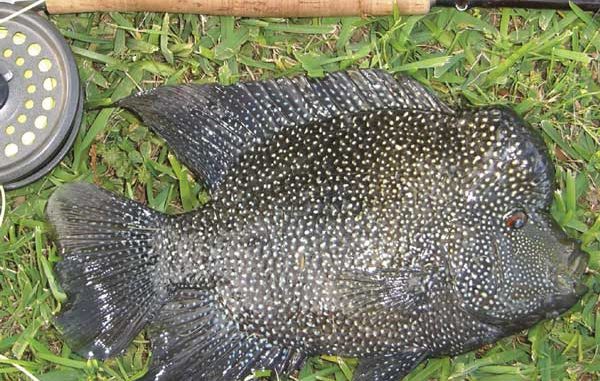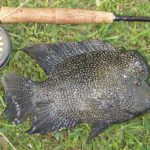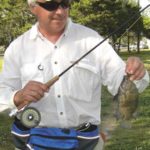
What could be finer than bank fishing on a sunny, mild spring day, listening to the sound of a jazz band playing nearby, and getting lots of rod-bending action on a three-weight rod?Spending a day in New Orleans isn’t what it used to be. Those days on Bourbon Street have been replaced by games in the Superdome and fishing in the many canals and bayous across town.
Fellow flyrodders are also flocking to the city to get in on the action of a species that resembles a bream on steroids. Hard to believe this was the biggest secret in South Louisiana.
Normally the Catchmeister has his finger on the pulse of flyfishing in Louisiana. I must confess I was kept out of the loop on this one. Looking back, it’s understandable. Now that the cat is out the bag, it may have done more harm than good.
About seven years ago, I heard a rumor that flyrodders in the New Orleans area were having a ball catching a non-native species called a cichlid. Cichlids are members of the family Cichlidae, and although they look like centrachidaes such as bluegill and redear, they are different in a variety of ways.
Cichlids are native to tropical regions of the world, and have no tolerance for cold. They are very protective parents. Some are even mouthbrooders. There are estimated to be more than 1,900 species of cichlids in Africa and South and Central America, but only one is native to the United States.
That one species is the Rio Grande cichlid, a fish I’ve become quite familiar with over the years.
My sons and I have fished for them in their native Hill Country streams and lakes of central Texas. We’ve also fished for Rios and many other cichlids in South Florida, where they were released into the canal systems by aquarium owners and became established. The canals that line the Tiamiami Trail Highway from Marcos Island to Miami contain huge numbers of these fish.
You’d think that a species that was such a highly successful breeder would overpopulate a water, resulting in stunted individuals. Quite the contrary. We’ve caught lots of cichlids over a pound in Florida, and many close to a pound in Texas.
What we’ve come to know and love about these fish is their love for flies, and once hooked, they have the tenacity of a wet bulldog. On the Cormier list of fly-friendly species, the Rio ranks in the top five ahead of the traditional favorite bluegill.
After Katrina, Kyle Moppert, a fellow member of the Red Stick Fly Fishers club, was in Jefferson Parish doing some surveys, and discovered loads of Rios lying in a parking lot where water from a nearby canal had flooded and receded. As a followup, he asked Tom Lorenz to give a program about these fish to our club.
Lorenz is a graduate student at UNO who has been examining the range, behavior and growth aspects of this invasive species. He explained that these and other cichlids have been dumped in the canals around New Orleans for decades, but the more cold-tolerant Rio — which can withstand water temperatures down to 55 degrees — was the only cichlid that became established.
Lorenz explained that this cichlid also has a tolerance for brackish water, and has been found along the south shore of Lake Pontchartrain and in the LaBranche Marsh west of the Jefferson Parish line. After Katrina, the Rio Grande range declined overall, but became the predominant species in most waters in Jefferson and Orleans parishes east of the river.
Part of his research was to determine the interactions between cichlids and native bluegill. There seems to be solid evidence that where Rios get established, they tend to outcompete bream for habitat and bedding areas. Lorenz found that a bluegill will defend its turf, but once a cichlid steals it away, the bluegill would rather switch than fight.
Incidently, the purpose of this research is to find a means to get rid of the Rio Grande cichlid from Louisiana waters.
With lots of spawning, good parenting and a tenacity to defend its home, the Rio Grande Perch could displace our native bluegill. But that simply hasn’t been the case elsewhere. Other researchers believe that its tolerance for poor water quality gives it an advantage in some waters.
Another phenomenon Lorenz and others have observed: During winter months, most of the Rios just tend to disappear. It’s as if they migrate through the canal system to find some haven of warmer water.
Heeding this info, I waited until after the annual City Park Big Bass rodeo to conduct my own personal research, using my TFO Finesse one-weight rod and a few jitterbees and cap spiders as technical equipment. I may have waited too long: Reports were hitting the Sportsman website about ice chests of chunky Rios being caught on a variety of lures and baits.
I worked the lagoons in City Park, as well as a couple sections of Bayou St. John. Maybe most of the big ones had been removed, since it was tough finding many fish over 6 inches. Still, that size Rio can make an impression on a one-weight rod.
However as the afternoon wore on, the action on larger fish picked up. I finally even nabbed a few big ones up to 10 inches, known among Rio enthusiasts as “Brainiacs” because of the large humps on their heads.
On several occasions, I found bream and cichlids in the same areas. However in the south lagoons, all I caught were bass or cichlids but no bream.
I must say this, however: The water in the south lagoons is very eutrophic. It’s the last place you’d ever want to wade. I caught a good number of these fish in inches-deep, stagnant water.
And that brings me to my soapbox. These Rios are amazing fish, able to survive in water no bluegill could. Perhaps these “illegal aliens” are like the human kind — willing and able to accept the waters our native fish refuse. Perhaps they do have a place in our fish society.
Fly rodders are a strange lot. We’re as fascinated by the odd species as we are about the size. Tell us a great river for the Gila trout — which gets to a whopping 10 inches — and we’ll mortgage our homes for airfare and a week’s stay.
So think about what this might do for New Orleans, if it were to manage and promote the Rio Grande cichlid fishery? Obviously, redfish and speckled trout would still rule supreme. But on those days when the wind isn’t friendly for saltwater action, the Rios could provide a welcome backup.
In the meantime, I hear the sales of one-weight fly rods have recently taken off in Southeast Louisiana.




